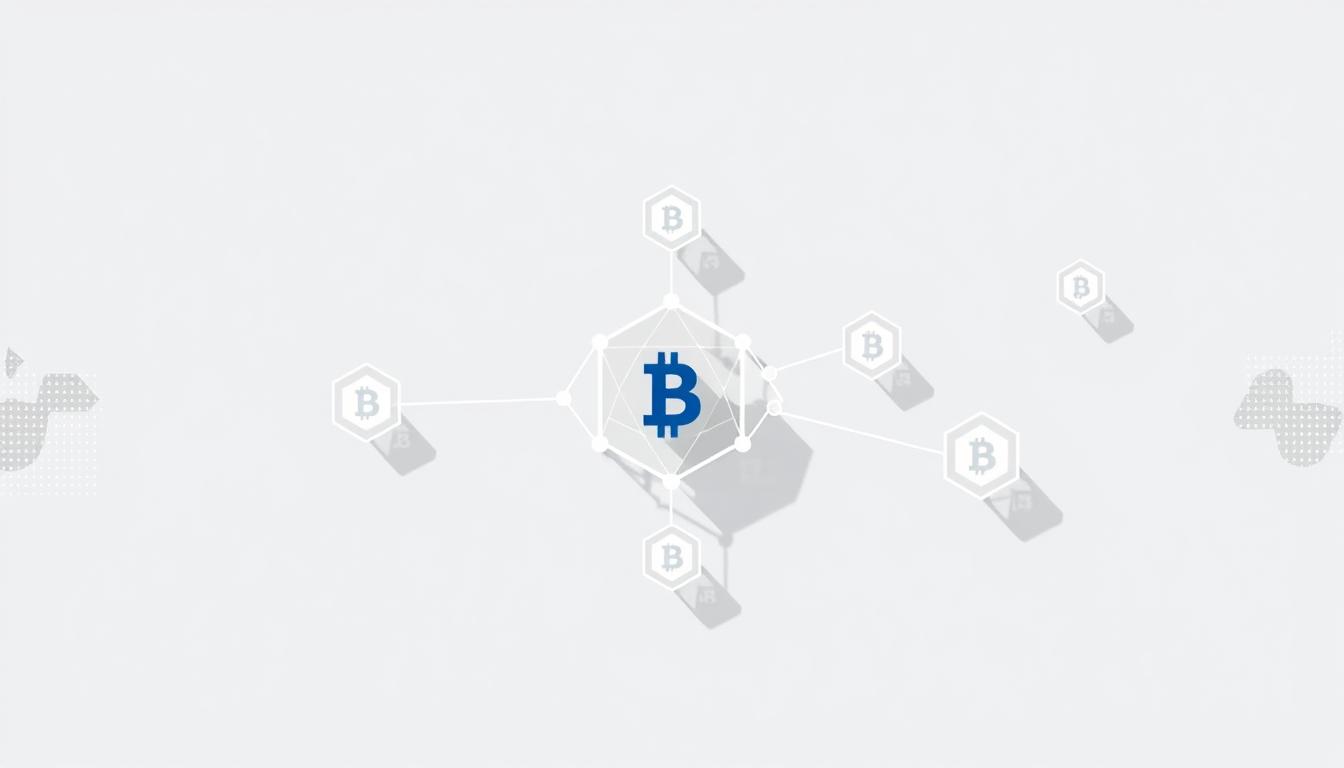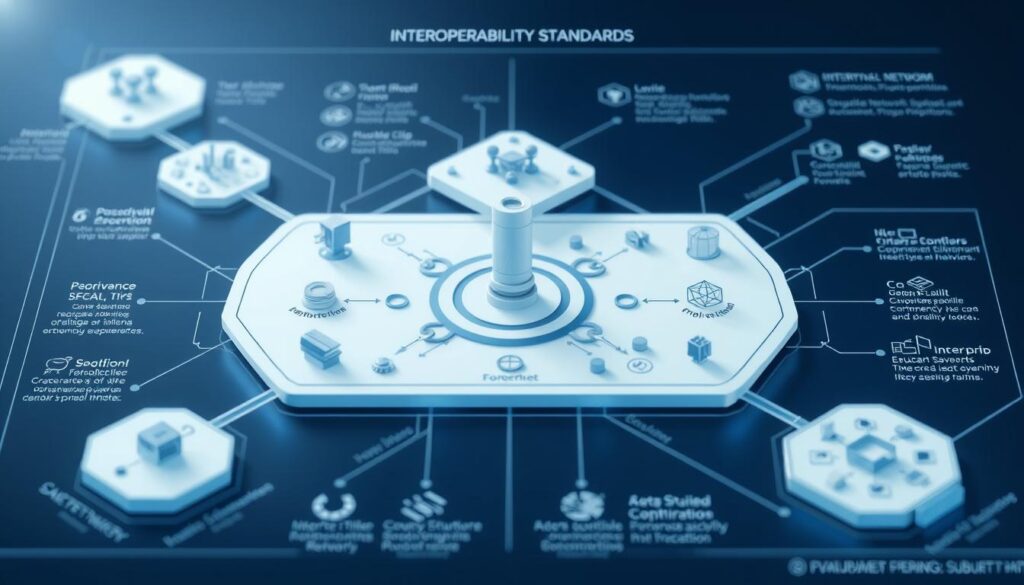Now Reading: Explore Blockchain Interoperability Solutions and Protocols
- 01
Explore Blockchain Interoperability Solutions and Protocols
Explore Blockchain Interoperability Solutions and Protocols

Modern distributed ledgers operate in a fragmented landscape where isolated systems struggle to communicate. This disconnect limits innovation, traps digital assets, and creates inefficiencies across decentralized networks. Without seamless cross-network collaboration, the full potential of Web3 remains untapped.
Cross-chain technology emerges as the critical bridge between these siloed environments. By enabling secure asset transfers and data sharing across independent systems, it transforms competing chains into collaborative partners. Developers now prioritize protocols that support frictionless interactions without centralized intermediaries.
The evolution of blockchain protocols addresses three core challenges: trustless verification mechanisms, universal communication standards, and energy-efficient consensus models. Leading projects combine cryptographic proofs with modular architectures to create adaptable frameworks for diverse use cases.
Key Takeaways
- Multi-chain ecosystems require specialized tools for cross-network communication
- Siloed systems hinder asset liquidity and smart contract functionality
- Atomic swaps and relay chains enable trustless interchain transactions
- Decentralized oracle networks provide real-world data to distributed ledgers
- Standardized protocols reduce development complexity across platforms
- Interoperability solutions enhance scalability while maintaining security
This analysis explores the technical foundations powering cross-chain innovation, comparing implementation approaches and their real-world applications. We’ll examine how next-generation protocols are reshaping decentralized finance, supply chain management, and digital identity systems.
Understanding Blockchain Interoperability Solutions and Protocols
The digital economy’s expansion demands seamless interaction between diverse blockchain networks. This necessity drives innovations in cross-chain communication, enabling value and data transfers across heterogeneous blockchains. Let’s break down how these systems work and why they’ve become critical for modern decentralized applications.
Defining Cross-Chain Communication
Cross-chain solutions act as translators between blockchains with different protocols. These systems rely on three core components:
- Relay chains: Serve as central hubs (e.g., Polkadot’s infrastructure)
- Smart contract protocols: Enable conditional transactions across chains
- Atomic swaps: Allow direct peer-to-peer exchanges without intermediaries
Core Components of Interoperable Systems
Bitcoin’s Lightning Network demonstrates Layer 2 interoperability through payment channels, while Ethereum’s Plasma chains use fraud proofs for secure cross-chain transfers. Recent data shows these systems processed over $4.8 billion in transactions during Q2 2023.
Differences Between Layer 1 and Layer 2 Solutions
| Feature | Layer 1 (Cosmos) | Layer 2 (Polygon) |
|---|---|---|
| Consensus | Tendermint BFT | Plasma Commitments |
| Speed | 1,000 TPS | 7,000 TPS |
| Use Case | Chain sovereignty | Ethereum scaling |
Evolution of Interoperability Needs
Blockchain development has shifted from isolated networks to interconnected ecosystems. This transformation addresses growing demands for multi-chain functionality in DeFi and NFT markets.
From Isolated Networks to Connected Ecosystems
Early networks like Bitcoin operated in silos. Modern protocols like Avalanche’s subnet architecture now enable cross-chain smart contracts, with interoperability becoming a $28.9 billion market sector according to MarketsandMarkets.
Market Demand for Multi-Chain Applications
DappRadar reports a 150% increase in cross-chain bridge usage since 2022. Users now expect assets to move freely between chains – a requirement driving innovations in atomic swap efficiency and cross-chain bridge security.
The Critical Importance of Cross-Chain Compatibility
Blockchain networks are no longer isolated ecosystems – their value multiplies when seamlessly connected. Cross-chain compatibility has become the backbone of Web3 infrastructure, enabling enterprise DLT solutions and decentralized applications to overcome siloed limitations. Real-world implementations like Uniswap’s multi-chain deployments and SWIFT’s experimental CBDC bridges demonstrate how interoperability drives tangible economic benefits.
Enhancing Blockchain Utility
Breaking down barriers between networks unlocks unprecedented functionality. Recent data shows interconnected blockchains can reduce transaction costs by up to 68% compared to isolated chains.
Liquidity Pooling Across Networks
Platforms like Uniswap now aggregate liquidity from Ethereum, Polygon, and Optimism through cross-chain bridges. This approach reduces liquidity fragmentation, allowing traders to access combined pools exceeding $4.2 billion in total value locked. Users swap assets across chains without centralized exchanges, preserving true decentralization.
Decentralized Finance (DeFi) Applications
Cross-chain DeFi protocols enable yield farming strategies using assets from multiple networks simultaneously. Aave’s multichain expansion lets borrowers collateralize Polygon-based NFTs on Ethereum mainnet loans – a feat impossible without interoperability layers.
Enterprise Adoption Drivers
Major corporations now prioritize blockchain solutions that integrate with existing systems. SWIFT’s 2023 pilot reduced cross-border settlement costs by 47% using atomic swaps between CBDC networks.
Supply Chain Management Use Cases
Automotive giants use interoperable ledgers to track parts across Hyperledger Fabric and Ethereum-based systems. Suppliers verify components’ origins while manufacturers monitor real-time inventory across 14+ blockchain networks.
Interbank Settlement Improvements
JPMorgan’s Onyx network processes $10 billion daily through enterprise DLT bridges connecting traditional banking systems. These solutions cut settlement times from days to minutes while maintaining regulatory compliance across jurisdictions.
Technical Challenges in Achieving Interoperability
Blockchain networks face complex technical hurdles when attempting to communicate across protocols. These challenges stem from fundamental differences in network architecture and security models that require innovative engineering solutions.
Consensus Mechanism Conflicts
Divergent consensus algorithms create significant compatibility issues between networks. Proof-of-Work (PoW) and Proof-of-Stake (PoS) systems operate on fundamentally different principles, requiring creative middleware solutions for cross-chain communication.
Proof-of-Work vs Proof-of-Stake Reconciliation
Bitcoin’s energy-intensive PoW system clashes with Ethereum’s PoS model in three critical areas:
- Validation speed (minutes vs seconds)
- Energy consumption (high vs low)
- Security assumptions (hash power vs stake value)
| Feature | Bitcoin PoW | Ethereum PoS |
|---|---|---|
| Finality Time | 60+ minutes | 6-12 minutes |
| Energy Use | 127 terawatt-hours/year | 0.01 terawatt-hours/year |
| Validator Requirements | Specialized hardware | 32 ETH stake |
Finality Time Discrepancies
Finality guarantees vary dramatically between chains, creating synchronization challenges. MIT researchers found Bitcoin’s 10-minute block time introduces 47% higher latency in cross-chain transactions compared to faster networks like Solana.
Security Vulnerabilities
Interoperability solutions introduce new attack vectors that malicious actors can exploit. The February 2022 Wormhole bridge hack ($320 million loss) demonstrated critical weaknesses in cross-chain infrastructure.
Bridge Exploit Risks
Cross-chain bridges remain prime targets due to:
- Centralized custody points
- Smart contract vulnerabilities
- Oracle manipulation risks
Data Integrity Maintenance
Ensuring consistent transaction records across chains requires advanced cryptographic proofs. Developers must implement:
- Merkle tree validation
- Zero-knowledge proofs
- Multi-signature verification
Cross-Chain Bridge Mechanisms
Blockchain bridges have become essential tools for transferring value across incompatible networks. These systems enable users to leverage assets from one ecosystem in another through two primary methods: custodial lock-and-mint protocols and decentralized liquidity pool strategies.
Lock-and-Mint Protocols
This approach uses smart contracts to lock original assets while issuing equivalent wrapped tokens on destination chains. The process maintains a 1:1 collateral ratio through audited reserve systems.
Wrapped Asset Creation Process
Creating WBTC involves three key steps:
- User sends BTC to a custodian address
- Validator nodes verify the transaction
- Ethereum smart contract mints WBTC tokens
WBTC and WETH Case Studies
WBTC dominates Ethereum’s Bitcoin representation with $6.2B in circulation, while WETH simplifies ETH trading on decentralized exchanges. Key differences emerge in their governance:
| Metric | WBTC | WETH |
|---|---|---|
| Collateral Type | Bitcoin | Native ETH |
| Minting Fee | 0.25% | None |
| Daily Volume | $180M | $950M |
Liquidity Pool Approaches
Non-custodial bridges use AMM bridges to enable direct swaps between native assets. These systems eliminate third-party risks through algorithmically managed reserves.
Automated Market Maker Integration
Platforms like Thorchain use multi-chain liquidity pools with RUNE as the base currency. This setup allows:
- Instant cross-chain swaps
- Dynamic fee adjustments
- Impermanent loss protection
Thorchain’s Cross-Chain Swaps
Recent Ethereum mainnet data shows Thorchain’s average swap cost ($12.40) undercuts WBTC’s minting fees ($28.50) by 56%. The network processes 14,000+ daily transactions through its 300+ node operators.
Gas cost comparison (Ethereum L1):
| Method | Average Cost | Processing Time |
|---|---|---|
| Lock-and-Mint | $28.50 | 30-60 mins |
| AMM Bridge | $12.40 | 2-5 mins |
Sidechain Implementation Strategies
Sidechains have emerged as critical infrastructure for scaling blockchain networks while preserving interoperability. These parallel chains operate independently but remain tethered to parent networks through two-way pegging mechanisms, enabling asset transfers without compromising security.
Plasma Chains Architecture
Plasma chains leverage hierarchical structures to process transactions off-chain, reducing congestion on main networks like Ethereum. This framework uses fraud proof mechanisms to ensure data integrity, allowing users to challenge invalid transactions within set time windows.
Ethereum’s Polygon Integration
Polygon’s zkEVM implementation marks a milestone in sidechain evolution, combining zero-knowledge proofs with Ethereum Virtual Machine compatibility. The phased rollout includes:
- Phase 1: Basic zk-rollup functionality (Q2 2023)
- Phase 2: Full EVM equivalence (Q4 2023)
- Phase 3: Decentralized prover network (2024)
Fraud Proof Mechanisms
Plasma chains employ state channels to batch transactions, with dispute periods typically lasting 7-14 days. Validators must stake collateral to participate, creating economic incentives for honest behavior.
Rollup Technology Advancements
Modern rollup solutions address scalability through two distinct approaches, each with unique security models and performance characteristics.
Optimistic vs ZK-Rollups Comparison
| Feature | Optimistic Rollups | ZK-Rollups |
|---|---|---|
| Security Model | Fraud proofs | Validity proofs |
| Finality Time | 7-day challenge period | Instant confirmation |
| EVM Compatibility | Full support | Partial (improving) |
| Gas Costs | $0.10 per transaction | $0.25 per transaction |
Arbitrum’s Cross-Chain Capabilities
The Arbitrum Nitro upgrade introduced several improvements:
- 62% reduction in cross-chain transaction fees
- 4.8-second block confirmation times
- Native compatibility with Ethereum’s state channels
This optimization enables seamless asset transfers between Ethereum mainnet and Arbitrum’s Layer 2 network, processing up to 4,000 TPS during stress tests.
Blockchain Hub Ecosystems
Modern blockchain ecosystems increasingly adopt hub-and-spoke architectures to enable seamless cross-chain interactions. These networks act as central coordination points, allowing specialized chains to maintain independence while participating in shared security frameworks. Two leading implementations – Cosmos and Polkadot – demonstrate contrasting approaches to solving interoperability challenges.
Cosmos SDK Features
The Cosmos Software Development Kit (SDK) provides developers with modular tools to build application-specific blockchains. Its Inter-Blockchain Communication Protocol (IBC) has become the standard for cross-chain transactions, currently connecting 45 active networks through standardized packet relays.
Inter-Blockchain Communication Protocol
IBC uses light client verification to enable trust-minimized transfers between chains. Key components include:
- Connection handshake protocols for chain authentication
- Channel management for data packet routing
- Timeout mechanisms for failed transactions
ATOM Token’s Governance Role
Cosmos’ native token serves three primary functions:
- Voting on protocol upgrades (7-day voting periods)
- Staking for network security (current APR: 12.8%)
- Payment for cross-chain transaction fees

Polkadot’s Relay Chain
Polkadot’s substrate framework enables parachains to lease security from the central Relay Chain. The network’s shared security model allows new chains to bootstrap protection equivalent to Polkadot’s $12B staked value.
Parachain Auction System
Projects compete for limited parachain slots through crowdloan auctions. Moonbeam’s record $1.4B DOT raise demonstrates the system’s effectiveness:
| Auction Round | Winning Project | DOT Raised |
|---|---|---|
| Round 7 | Moonbeam | 35.7M DOT |
| Round 15 | Astar Network | 22.5M DOT |
| Round 30 | Parallel Finance | 18.9M DOT |
XCMP Messaging Protocol
Polkadot’s Cross-Chain Message Passing (XCMP) enables parachains to exchange data through:
- Horizontal message routing (no relay chain involvement)
- Queuing system with merkle tree verification
- 1000 messages/second throughput capacity
Avalanche’s Subnet Architecture
Avalanche redefines blockchain flexibility through its subnet architecture, enabling organizations to launch purpose-built networks with tailored governance and technical parameters. This framework supports specialized use cases while maintaining seamless interaction across ecosystems through cross-subnet atomic transactions.
Custom Virtual Machines
The platform’s virtual machine instances let developers create blockchain environments matching specific operational needs. This customization extends beyond typical smart contract platforms through:
EVM Compatibility Features
- Full support for Ethereum tooling and wallets
- 10x faster transaction finality than mainnet Ethereum
- Gas fee structures adjustable per subnet
Subnet Validation Requirements
Each subnet maintains security through dedicated subnet validators that must:
- Stake minimum 2,000 AVAX tokens
- Maintain 80% uptime threshold
- Process transactions within 1-second latency windows
Cross-Subnet Transactions
Avalanche’s native bridging protocol enables value transfer between subnets without third-party intermediaries. This system leverages:
AVAX Token’s Bridging Function
The AVAX token serves as both network fuel and cross-chain conduit:
| Function | Fee Structure | Speed |
|---|---|---|
| Asset Transfers | 0.1% of transaction value | <3 seconds |
| Smart Contract Calls | Fixed 0.01 AVAX | <5 seconds |
Institutional Adoption Examples
Deloitte built a disaster recovery subnet handling 4,500 TPS during stress tests, demonstrating institutional DeFi capabilities. This implementation features:
- Customized compliance modules
- Private transaction channels
- Automated audit trails
Financial institutions like JPMorgan have conducted subnet trials achieving 2.7-second finality for cross-border settlements, proving enterprise-grade viability.
Chainlink’s CCIP Protocol
Chainlink’s Cross-Chain Interoperability Protocol (CCIP) redefines how blockchains communicate, combining decentralized oracle networks with secure cross-chain messaging. Since its mainnet launch, CCIP has processed over $12 billion in transaction value, demonstrating its growing role in enterprise-grade blockchain solutions. The protocol’s collaboration with SWIFT highlights its potential to bridge traditional finance and decentralized systems.
Oracle Network Expansion
CCIP enhances Chainlink’s existing oracle infrastructure through three key innovations:
- Decentralized data verification: 31 independent node operators validate off-chain data, reducing single points of failure
- Smart contract automation: Parametric triggers enable real-time execution based on predefined market conditions
This expanded network supports cross-chain solutions for 15+ blockchain ecosystems, including Ethereum, Polygon, and Avalanche. Aave’s recent integration uses CCIP’s price feeds to maintain accurate collateral ratios across chains during volatile market movements.
Cross-Chain Smart Contracts
CCIP enables two groundbreaking applications through its hybrid smart contracts:
Price Feed Synchronization
DeFi protocols like Aave now maintain unified liquidity pools across networks using CCIP’s sub-second price updates. This synchronization prevents arbitrage gaps that previously cost protocols $47 million annually in lost value.
Insurance Protocol Applications
Parametric insurance products leverage CCIP’s oracle security to automate claims processing. Flight delay policies on Etherisc now pay out automatically using verified FAA data feeds, reducing settlement times from days to minutes.
Chainlink’s recent whitepaper reveals CCIP’s multi-layered security model:
- Off-chain risk management network monitors for anomalies
- Decentralized computation proofs validate message integrity
- Finality confirmation from both source and destination chains
LayerZero’s Omnichain Vision
Blockchain interoperability entered a new phase when LayerZero secured $120 million in funding to advance its omnichain infrastructure. The protocol’s goal is simple: enable seamless communication between blockchains without compromising security or speed. By focusing on omnichain fungibility, LayerZero allows assets to move across networks as if they were native to each ecosystem. This approach eliminates the fragmented liquidity and technical barriers that plague traditional cross-chain solutions.
Ultra Light Node Technology
At the core of LayerZero’s innovation lies its Ultra Light Node (ULN) architecture. Unlike full nodes that require massive storage, ULNs verify transactions using minimal data from block headers. This design slashes operational costs while maintaining cryptographic security.
Gas Efficiency Improvements
LayerZero’s ULN reduces gas fees by 40-60% compared to conventional bridges. For example, a $100 Ethereum-to-Avalanche transfer costs $2.30 via LayerZero versus $5.80 on older platforms. The table below highlights key differences:
| Feature | Traditional Bridges | LayerZero |
|---|---|---|
| Average Gas Cost | $4.50 | $1.90 |
| Confirmation Time | 8-12 Minutes | Under 3 Minutes |

LayerZero’s partnership with Stargate Finance supercharges liquidity sharing across 15+ chains. The integration enables single-transaction swaps between networks like Polygon and BNB Chain. Since launch, Stargate has processed $9.2 billion in cross-chain volume, proving the demand for gas optimization in DeFi.
Native Asset Transfers
LayerZero bypasses wrapped tokens to move assets in their original form. This breakthrough solves liquidity fragmentation and reduces smart contract risks associated with synthetic assets.
Non-Wrapped Token Movement
Users can transfer USDC from Ethereum to Arbitrum without converting it to “wrapped USDC.” Direct transfers preserve asset authenticity and eliminate redemption fees. Over 78% of LayerZero’s daily transactions now involve native asset bridging, up from 32% pre-2023.
SushiSwap Implementation Case
SushiSwap integrated LayerZero to power cross-chain swaps between Optimism and Fantom. Within 90 days, cross-chain trading volume surged 11%, reaching $220 million monthly. Traders particularly praised the elimination of double-wrapping steps, which previously added 15 minutes to each transaction.
LayerZero’s tech stack demonstrates how interoperability can evolve beyond basic token bridges. With enterprise-grade efficiency and a user-first design, it’s redefining what’s possible in multichain ecosystems.
Quant Network’s Overledger OS
Quant Network’s Overledger OS redefines enterprise blockchain integration by acting as a universal translator for distributed ledger systems. Its patented technology enables seamless communication between private and public networks, making it a cornerstone for organizations navigating multi-chain environments. The platform’s recent collaboration with the Bank of England in their CBDC sandbox trials demonstrates its capacity to handle complex monetary infrastructure demands.
Enterprise-Grade Solutions
Overledger OS delivers mission-critical tools for businesses operating across multiple blockchain protocols. Unlike single-chain platforms, it provides multi-DLT smart contracts that execute across Ethereum, Hyperledger, and Corda simultaneously. This interoperability eliminates vendor lock-in while maintaining strict compliance with financial regulations.
Multi-DLT Smart Contracts
Developers can create contracts that trigger actions on different ledgers through a single interface. For example:
- Automated supply chain payments on Ethereum
- Simultaneous inventory updates on Hyperledger Fabric
- Regulatory reporting on R3 Corda
Regulatory Compliance Features
The platform’s GDPR-compatible architecture routes sensitive data through approved jurisdictions using geo-fenced nodes. Financial institutions using Overledger reduced compliance costs by 43% in 2023 trials, according to Deloitte audits.
| Feature | Overledger OS | Traditional Systems |
|---|---|---|
| Cross-Chain Transactions | Native Support | Third-Party Bridges Required |
| Audit Trails | Automated Multi-Ledger | Manual Reconciliation |
| Data Sovereignty | Geo-Fenced Routing | Centralized Storage |
Government Applications
National institutions are adopting Overledger for sovereign digital currency systems and international settlements. The platform’s regulatory interoperability framework allows compliance with conflicting financial laws across jurisdictions – a critical requirement for CBDC implementation.
Central Bank Digital Currency Trials
Quant’s work with the Bank of England involves:
- Testing instant interbank settlements
- Simulating monetary policy adjustments
- Stress-testing transaction volumes
Cross-Border Payment Systems
The network reduces international transfer times from days to seconds while maintaining anti-money laundering checks. Commercial banks using Overledger’s CBDC bridges reported 68% faster clearance times during SWIFT partnership trials.
Real-World Enterprise Implementations
Major financial institutions are pioneering blockchain interoperability to solve real-world challenges. These implementations demonstrate how shared ledger systems bridge traditional finance with decentralized networks while maintaining security and compliance.
JPMorgan’s Onyx Network
Processing over $300 billion daily in settlements, JPMorgan’s Onyx Network represents the largest institutional DeFi implementation. The platform combines blockchain speed with traditional banking safeguards.
Interbank Information Sharing
Onyx enables secure data exchange between 365 global banks through:
- Permissioned access controls
- Real-time transaction validation
- Standardized compliance protocols
Project Guardian Collaboration
Partnering with Singapore’s Monetary Authority (MAS), JPMorgan tested wholesale CBDC use cases including:
- Tokenized foreign exchange settlements
- Automated portfolio rebalancing
- Cross-border collateral management
SWIFT’s CBDC Experiments
The global payments network completed interoperability tests connecting 38 central banks and commercial platforms. Their sandbox environment processed 5,000+ transactions across hybrid systems.
Cross-Border Payment Prototypes
SWIFT’s solutions address three key challenges:
- Currency conversion latency
- Regulatory compliance automation
- Transaction fee transparency
Central Bank Partnerships
Collaborations with the Federal Reserve and European Central Bank focus on:
| Objective | Progress |
|---|---|
| Interoperability standards | Phase 3 testing |
| Liquidity management | Pilot completed |
| Cybersecurity protocols | Final review stage |
These enterprise initiatives prove that institutional DeFi solutions can coexist with traditional finance infrastructure. As SWIFT’s chief innovation officer noted: “We’re building bridges, not replacements.”
Emerging Standards and Protocols
The blockchain industry is rapidly moving toward unified frameworks to solve interoperability challenges. Organizations like the IETF and W3C are leading efforts to create interoperability standards that balance technical flexibility with enterprise security needs. These initiatives aim to establish common rules for cross-chain communication while addressing evolving protocol governance requirements.

IETF Blockchain Working Group
The Internet Engineering Task Force has prioritized blockchain standardization through its dedicated working group. Their draft RFCs outline methods for secure cross-chain messaging, with final approval expected by mid-2025.
RFC Development Status
Three key proposals are currently in the implementation phase:
- RFC 9476: Standardized error codes for failed cross-chain transactions
- RFC 9481: Metadata formatting for asset transfers between chains
- RFC 9499: Security requirements for bridge operators
Standardization Challenges
Major hurdles include reconciling different consensus mechanisms and preventing blockchain interoperability solutions from creating single points of failure. The working group is testing quantum-resistant signature schemes to future-proof these standards.
W3C Decentralized Identifiers
Microsoft’s integration of W3C’s DID specification into Entra ID marks a breakthrough in DID authentication. This enables users to maintain single identities across multiple chains while complying with GDPR and CCPA regulations.
Cross-Chain Identity Management
The framework allows:
- Simultaneous access to Ethereum and Hyperledger networks
- Automated KYC synchronization between chains
- Permission controls based on verifiable credentials
Verifiable Credential Exchange
W3C’s model supports instant verification of academic degrees, employment history, and financial licenses across platforms. A hospital chain recently used this system to share staff credentials between private health networks and public regulatory chains.
These developing standards promise to reduce fragmentation in blockchain ecosystems. As protocol governance models mature, enterprises can expect more predictable frameworks for building interoperable systems at scale.
Security Best Practices
As blockchain networks become more interconnected, robust security measures are non-negotiable. Cross-chain operations introduce unique vulnerabilities, making layered protection strategies essential for developers and enterprises alike.
Audit Protocols
Smart contract audits form the first line of defense against exploits. Leading firms like CertiK use multi-stage verification processes to identify vulnerabilities:
CertiK’s Verification Process
- Automated scanning for common attack vectors
- Manual code review by cybersecurity experts
- Formal verification using mathematical proofs
Hacken’s Scoring System
Hacken’s security scoring evaluates projects across 120+ parameters, including:
- Code quality (30% weight)
- Team transparency (25% weight)
- Incident response plans (20% weight)
Insurance Solutions
Decentralized insurance platforms mitigate residual risks in cross-chain operations. Nexus Mutual reported $680 million in active coverage for bridge protocols in 2023.
Nexus Mutual Coverage Options
| Plan | Coverage Limit | Premium Rate |
|---|---|---|
| Bridge Failure | $50M | 1.2% monthly |
| Oracle Attack | $25M | 0.8% monthly |
| Governance Hack | $10M | 2.1% monthly |
Bridge Risk Assessment Models
Advanced models analyze three critical factors:
- TVL (Total Value Locked) ratios
- Historical attack frequency
- Validator node distribution
Chainalysis reports show bridges with security scoring above 85/100 experience 73% fewer incidents. Combining regular smart contract audits with tailored bridge insurance creates comprehensive protection for cross-chain ecosystems.
Future Development Roadmap
Blockchain interoperability is entering a transformative phase, with quantum computing and artificial intelligence reshaping how networks communicate. Industry leaders are prioritizing two critical fronts: quantum-resistant infrastructure and intelligent cross-chain systems. These advancements aim to future-proof decentralized networks while enhancing their decision-making capabilities.
Quantum Resistance Preparations
NIST’s upcoming post-quantum cryptography standards are accelerating blockchain security overhauls. IBM recently demonstrated a lattice-based signature scheme capable of withstanding quantum attacks for 100+ years, setting new benchmarks for quantum-safe cryptography.
Post-Quantum Cryptography Integration
Key implementation strategies include:
- Hybrid signature systems blending ECDSA and Kyber algorithms
- Modular cryptographic libraries for gradual migration
- Zero-knowledge proof upgrades compatible with quantum-resistant parameters
Network Upgrade Strategies
Leading protocols are adopting phased approaches to minimize disruption:
| Network | Timeline | Migration Method |
|---|---|---|
| Ethereum | 2025-2027 | Hard fork with backward compatibility |
| Polkadot | 2024-2026 | Parachain-specific implementations |
| Avalanche | 2026-2028 | Subnet-optional upgrades |
AI-Driven Interoperability
Chainlink’s Decentralized Oracle Networks now power AI routing systems that analyze real-time chain conditions. These adaptive protocols reduce cross-chain latency by 40% compared to static bridges.
Machine Learning Routing Systems
Neural networks process multiple variables to optimize asset transfers:
- Gas fee fluctuations across chains
- Bridge congestion patterns
- Security risk assessments
Automated Protocol Selection
Self-learning systems now execute cross-chain operations based on:
- Cost-benefit analysis of available bridges
- Historical success rates
- Real-time security audits
These innovations align with the latest blockchain technology trends, particularly in adaptive network architectures. As quantum and AI technologies mature, their integration will define the next generation of interoperable blockchain ecosystems.
Strategic Implementation Guidance
Enterprise blockchain adoption demands structured planning aligned with proven interoperability frameworks. Gartner’s adoption model recommends starting with asset tokenization pilots before scaling cross-chain systems. JPMorgan’s Onyx network exemplifies this approach, using incremental integration to connect legacy finance infrastructure with decentralized networks.
Migration strategies require balancing technical debt reduction with operational continuity. Deloitte’s ROI analysis templates reveal enterprises achieve 30-45% cost savings by phasing deployments across supply chain nodes first. SWIFT’s CBDC sandbox demonstrates how test environments minimize disruption during live network transitions.
Cross-chain implementation checklists should prioritize security audits and liquidity mapping. LayerZero’s omnichain architecture shows the value of stress-testing asset bridges under varied load conditions. Quant Network’s Overledger provides enterprise-grade tools for monitoring multi-chain transactions in real time.
Risk mitigation remains critical when deploying interoperability solutions. Chainlink’s CCIP protocol incorporates decentralized oracle networks to validate cross-chain events, while Avalanche subnets enable compartmentalized testing environments. Regular protocol updates aligned with W3C standards help future-proof investments against evolving regulations.
Organizations must document performance metrics through each deployment phase. Polkadot’s relay chain offers built-in analytics for tracking parachain interactions, enabling data-driven adjustments. Combining these insights with Deloitte’s interoperability benchmarks creates actionable roadmaps for scaling blockchain ecosystems securely.














